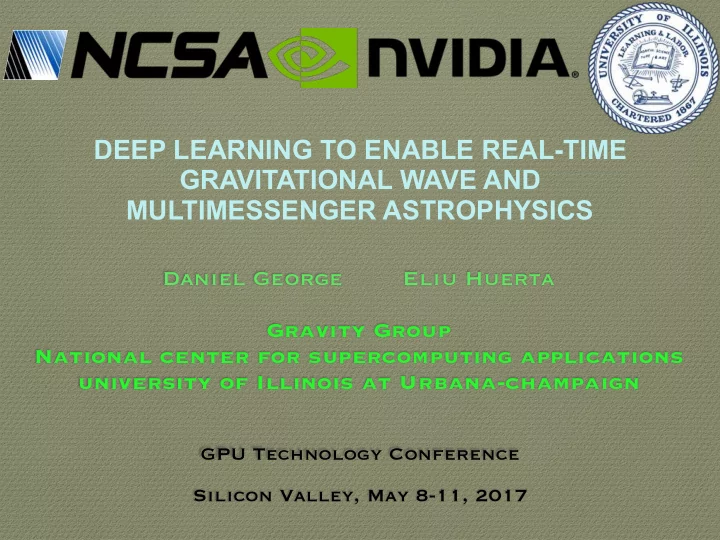

DEEP LEARNING TO ENABLE REAL-TIME GRAVITATIONAL WAVE AND MULTIMESSENGER ASTROPHYSICS Daniel George Eliu Huerta Gravity Group National center for supercomputing applications university of Illinois at Urbana-champaign GPU Technology Conference Silicon Valley, May 8-11, 2017
(C) NASA (C) SWIFT Enlightened by light and astroparticles (C) NASA (C) ICE CUBE (C) LHC (C) IMGRES (C) ESA What about events that do not emit light?
From darkness to sound (C) NCSA Some of the most fascinating astrophysical phenomena are governed by strong gravitational interactions (C) BBC Numerically simulate extreme astrophysical environments using supercomputers
From darkness to sound The most sensitive detectors ever constructed by humankind LIGO Livingston LIGO Handford https://www.kaistaats.com/film/ligo-detection/
From darkness to sound Detecting gravitational waves with LIGO requires measuring the distance between the Earth and Proxima Centauri with a precession better than a few microns! 4.24 light years
XXI century physics The discovery of the century (C) NCSA
XXI century physics The discovery of the century There is much more than collisions of black holes Collisions of neutron stars and black hole-neutron stars are expected to produce electromagnetic and astroparticle counterparts: the holy grail of multimessenger astrophysics
(C) NCSA Gravity Group
What have we accomplished? Gravitational waves have been detected Confirmed: binary systems of black holes form and coalesce within the age of the Universe Worldwide effort brought together a rich ecosystem of scientists: experimental and theoretical physicists, computer scientists, HPC, HTC, OSG, data analysts, outreach
Models and simulations Scientific Discovery Observations Theory G µ ν = 8 π T µ ν Detected: binary black holes Future: supernovae collapse, gamma-ray bursts, oscillating neutron stars…
What is happening now? More detectors, more data, more opportunities, more resources (?) (C) LIGO Kilometer scale multidetector network Longer gravitational wave detection campaigns More sensitive detectors
Computational challenges Network throughput of gravitational wave data transfer is 1MB/sec. Raw data are a factor 10-30 larger Gravitational wave searches currently target a narrow class of astrophysical events (3D). Increasing the depth of existing searches is computationally prohibitive (8D) Some types of gravitational wave signals go unnoticed with existing detection algorithms
Computational challenges Current and future portfolio of NSF-supported National Computing Resources Complements Larger Aggregate Investments from Universities and other Agencies 2013 2014 2015 2016 2017 2018 2019 2020 2021 2022 2023 2024 2025 2026 ... Blue Waters /UIUC Leadership HPC Planning 2 to 3x Time-To-Solution Improvement > 20x Improvement Stampede/ UT Austin Stampede2/ UT Austin Yellowstone/N CAR-Wyoming Cheyenne/NCAR Comet/UCSD Wrangler /UT Austin Bridges /CMU/PSC Jetstream/Indiana U. Key: Blue: Large-scale Potential Renewal National HPC Resource computation National HPC Resource Red : Long-tail and high- throughput Green : Data Intensive Orange: Cloud
It is time to connect our successful present with a bright future Waveform templates: seconds to minutes Current challenges can only be overcome through innovation Waveform templates: minutes to years Leverage existing HPC and HTC infrastructure with recent breakthroughs in artificial intelligence
Recommend
More recommend